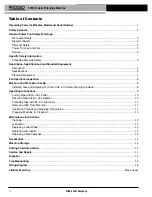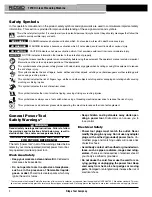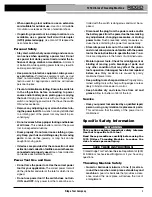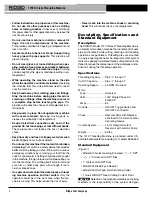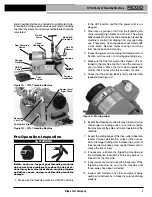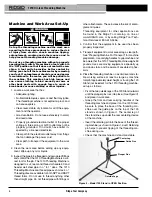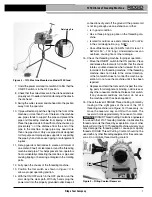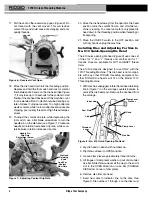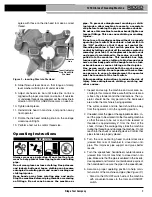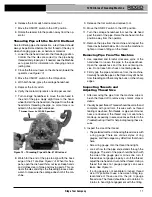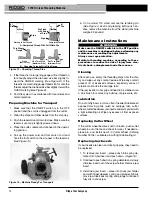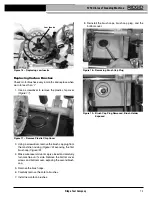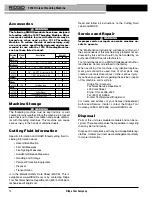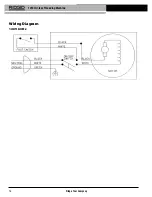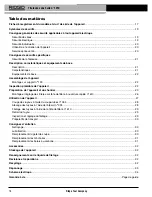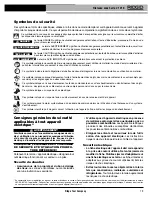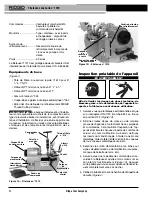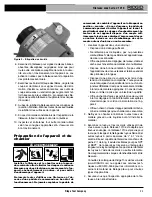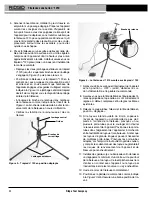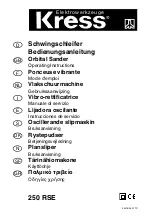
pipe. To prevent entanglement crushing or strik-
ing injuries, allow machine to come to a complete
stop before touching the pipe or machine chucks.
Do not use this machine to make or break (tighten or
loosen) fittings. This can cause striking or crushing
injuries.
Do not use a threading machine without a properly
operating foot switch. Never block a foot switch in
the “ON” position so that it does not control the
threading machine. A foot switch provides better
control by letting you shut off the machine motor by
removing your foot. If entanglement should occur
and power is maintained to the motor, you will be
pulled into the machine. This machine has high
torque and can cause clothing to bind around your
arm or other body parts with enough force to crush
or break bones or cause striking or other injuries.
One person must control both the work process
and the foot switch. Do not operate with more than
one person. In case of entanglement, the operator
must be in control of the foot switch.
Follow operating instructions to reduce the risk of
injury from entanglement, striking, crushing and
other causes.
1. Inspect and set-up the machine and work area ac-
cording to this manual. Make sure that the work area
is free of by-standers and other distractions. The op-
erator should be the only person in the barricaded
area while the machine is being operated.
The cutter, reamer and die head should be away
from the operator, not in the operating position.
2. If needed, mark the pipe at the appropriate location. In-
sert the pipe to be worked into the threading machine
so that the area to be cut or end to be reamed or
threaded is approximately 4" from the front of the
chuck. If closer, the carriage may strike the machine
during the threading and damage the machine. Do not
reach into the chuck or centering device. Confirm that
pipe stands are properly placed.
3. Turn the rear centering head counterclockwise
(viewed from rear of machine) to close down onto
pipe. This improves pipe support and gives better
results.
4. Turn the speedchuck handwheel counterclockwise
(viewed from front of machine) to close down onto
pipe. Make sure that the pipe is centered in the inserts.
Use repeated and forceful counterclockwise spins of
the handwheel to secure the pipe in the speedchuck.
5. Assume a proper operating position to help main-
tain control of the machine and pipe
(See Figure 10).
• Stand on the ON/OFF switch side of the machine
with convenient access to the tools and ON/OFF
switch.
agree with those on the die head to make a correct
thread.
Figure 9 – Inserting Dies Into Die Head
8. Slide throwout lever back so that tongue of clamp
lever washer will drop in slot under size bar.
9. Adjust die head size bar until index line on link is
aligned with proper size mark on size bar. If oversize
or undersize threads are required, set the index line in
direction of OVER or UNDER size mark on size bar.
10. Tighten clamp lever.
11. Reinstall die head in machine, and position away
from operator.
12. Rotate the die head retaining knob on the carriage
clockwise until tight.
13. Perform a test cut to confirm thread size.
Operating Instructions
WARNING
Always wear eye protection. Wear steel toe foot-
wear to help protect from tipping tools and falling
pipe.
Do not wear gloves or loose clothing. Keep sleeves
and jackets buttoned. Loose clothing can become
entangled in rotating parts and cause crushing and
striking injuries.
Keep hands away from rotating pipe and parts.
Stop the machine before wiping threads or screwing
on fittings. Do not reach across the machine or
Ridge Tool Company
9
1210 Oil-less Threading Machine
Indicator
Line
Insert Indicator
Line Flush With
Die Head


